Ordsall All HallowsArchaeology
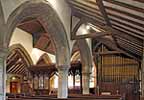 The
south arcade The
south arcade
looking east |
 The north arcade The north arcade
looking east |
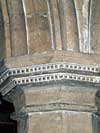 Nailhead decoration Nailhead decoration
on north arcade capital |
The church is a building of stone, chiefly in the early Decorated style, consisting of chancel, nave, north and south aisles, south porch, and west tower. The embattled west tower is Perpendicular in style and is constructed of ashlar, has diagonal buttresses, battlements and eight pinnacles.
The arcades of four bays, separating the nave and aisles are both Early English. The oldest part of the building dates from the mid 13th century, the oldest part being in the octagonal pillars of the north aisle. Two of the capitals have nailhead ornament. On the south arcade, the third pier from east has four shafts attached at the diagonals, and the east and west responds both have keeled shafts. The stepped-profile arches have complex mouldings including more keels; this suggests a 13th century date. The north and south arcades probably have different construction periods within the same century.
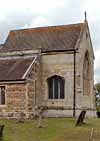 The chancel from The chancel from
the south-east |
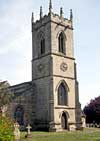 The tower from The tower from
the north-west |
The chancel probably dates from the 15th century, though it has been heavily restored and there is no longer a chancel arch. The aisles continue one bay into the chancel proper and thus orginally formed two side chapels; there is now an north chapel, whilst the south bay serves as the organ chamber.
The tower was built in four stages with a spiral staircase in the south-west corner. The whole of the tower dates from the 15th century, though the upper part was completely rebuilt at the restoration in 1877. The pinnacles and battlements were taken down and re-built. Each stone was marked so that it could go back in the same place. The side aisles were totally renewed at the same time. The chancel roof was, prior to the restoration, flat and covered with lead.
The church was said to be in a dilapidated state until 1831 when a programme of restoration was undertaken. This included replacing old oak benches by high-backed, ill-arranged pews. A quote from the time describes 'the chancel itself was encroached upon to make some room for an unseemly pulpit which reared its head out of its very midst, and, strange to say, these then considered improvements were carried out underneath a roof which was at the same time forcing the walls asunder from its sheer decay.'
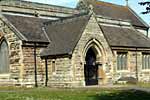 The south porch The south porch
of 1877 |
By 1876 this was found to be of poor quality and unfit for the increase in parishioners, so another major restoration was undertaken in 1877 and a lot of what can be seen today dates or post dates that period. The architect for this project was T.C. Hine of Nottingham. It was recorded that some the pillars of the arcades were 'very much out of the perpendicular but could be restored. Something was also needed to bring the walls of the North and South aisles straight.' The chancel roof was restored to a steep pitch, the nave roof which remained sound had its flat plaster ceiling replaced by a sloping panelled casting underneath the roof spars, formed by the old pew doors. The side aisles were moved back to make the chancel 12ft wider. The south porch was demolished and rebuilt, the organ was added and the large east window accommodated, by the raising the chancel roof making it a different pitch to the nave. New choir stalls were built in 1881. The singers had previously sat in the gallery at the west end which became the ringers’ loft.
In 1906 a faculty was obtained to construct an underground chamber below the vestry (at that time the side chapel we know today), the entry being gained by a flight of steps outside the church (now in the current vestry). This was to house a proposed new heating system.
In 1929 an architect’s report on the building reported that 'All the joints between stones needed raking out and re-pointing. This has been done with Mastic Cement. The side aisles were rebuilt in 1877 and had been widened. They are not built of dressed Roche Abbey or other stone like some parts of the church, and in places the exterior walls are merely a collection of rubble and mortar.' This observation went on to describe the subsequent dampness caused to the inner stone work. It was reported later that year that the church was again watertight.
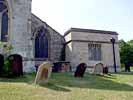 The vestry from The vestry from
the west |
Work started on the present vestry in 1934. The building was erected on a concrete raft with reinforced metal work supplied by a firm from Staffordshire. The walls are of Ancaster stone and windows and coping are of White Mansfield stone. A new doorway had to be made from the area then used as the vestry (side chapel) and was through the wall which was 3ft thick and had a rubble core of stone and mortar. The roof was to be of heavy leaded sheets. The vestry was built by Richmond and Son of Retford. The clergy vestry was given by Mrs Haigh in memory of her late husband. The finishing touches were still being applied in 1937.
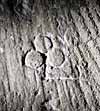 |
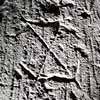 |
| Masons' marks |
Access to the ringer’s gallery, at this time, was by a trap door and ladder, so a new door was made in 1937. A new door was made through the wall of the turret staircase. This undisturbed part of the church fabric uncovered various kinds of stone – Roche Abbey, Tuxford, Steetley, and Ancaster – all used in making the rubble wall inside. It also uncovered some masons' marks cut on the stone which are found on other towers and churches in the area.
In March 1952, due to attacks of woodworm, the majority of the woodwork within the tower was completely replaced. This included the whole of the floor of the ringing gallery, the ceiling of the clock chamber and several cupboards and the wooden channels containing the clock weights. The remaining woodwork was treated.
More recently several pews have been removed from the back of the church to provide a social area where tea and coffee can be served and children’s activities can be provided. The area beneath the tower has been adapted to provide a small area for a sink and storage for cups etc. The work space is used to prepare drinks for Sunday service and Open Church events.
A toilet is also available through the vestry.
Medieval cross slab
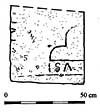 Cross slab fragment Cross slab fragment |
Apart from the tower and chancel much of the external walls of the church are 19th century rebuilding. A cross slab fragment has been re-used as the internal threshold of the west door of the tower. In the floor of the north aisle is a slab with remnants of a black-letter inscription and a fragment of incised design at one corner, which has more the look of having been an incised effigy rather than a cross slab.
(1) Part of the base of what appears to have been a floor stone cross slab, with an incised design. Section of stepped base with rounded steps, with border panel and a letter or two of a marginal inscription; the style of the letters looks late, post black letter, so perhaps 16th century or even early Post-Reformation.
Description and drawing of the cross slab courtesy of Peter Ryder.
Technical Summary
Timbers and roofs
|
NAVE |
CHANCEL |
TOWER |
| Main |
Pitched roof with ties, king posts, and carved queen post to principal rafters; ridge and side purlins, boarded above, all 1877. |
4-way pitch, matchboarded ceiling with panels of alternate angled boards, moulded ridge and side purlins and decorated wall plates. Probably all 1877. |
Composite roof with two east-west ties of probably C19th date, with C20th cross ties below and C20th boarding above, all probably 1952. Flagpole support, and modern steel bolts. |
| S.Aisle |
Pitched roof, lean-to form with principal rafters, central purlin, and straight brace with curved collar; probably all 1877. |
As S.aisle |
|
| N.Aisle |
Pitched roof, lean-to form with principal rafters, central purlin, and straight brace with curved collar; probably all 1877. |
As N.aisle |
|
| Other principal |
|
|
|
| Other timbers |
|
|
|
Bellframe
Composite wood and cast iron frame: Pickford Group 8.2.C, with wooden head and cill timbers and cast iron 'H' sections bolted to cill and head. 1892, probably by Taylors of Loughborough when they recast bells 1-4.
Not scheduled for preservation Grade 4.
Walls
|
NAVE |
CHANCEL |
TOWER |
| Plaster covering & date |
Open stonework on aisle walls, plastered and painted in nave |
Plastered and painted |
Open stonework. |
| Potential for wall paintings |
None. |
No visible evidence; potential unknown. |
None. |
Excavations and potential for survival of below-ground archaeology
No known archaeological excavations have been undertaken.
The fabric dates principally from the C13th to the C15th with a major restoration and some rebuilding of the aisles and renovation of the chancel in 1876-7; there had been a refitting in 1831 and the tower was partially restored in 1877 and 1952. The south porch was rebuilt in 1877. The majority of the core medieval fabric of nave, tower, and chancel, remains intact. The earliest evidence is from the mid-C13th in the aisle arcades. The roofs in the body of the church are mainly C19th replacements. There is a single medieval cross slab fragment in the base of the tower.
The churchyard is irregular in shape but was originally probably rectangular with the church offset to the west side of the churchyard. There are burials on all sides.
The overall potential for the survival of below-ground archaeology in the churchyard is considered to be HIGH comprising medieval construction evidence, burials, and landscaping, extensions and possibly pre-churchyard use, and also evidence for the rebuilding of the aisle walls in 1876-7. Below the present interior floors of the church it is considered to be HIGH comprising medieval-C19th stratigraphy with post-medieval burials. The archaeology of the upstanding fabric is a mixture of medieval and 1876-7, and its archaeological potential is HIGH.
Exterior: Burial numbers expected to be average or slightly above below average due to the proximity to Retford.
Interior: Stratigraphy under the entire building is likely to be medieval with later layers and much restoration evidence. In the body of the church the stratigraphy is likely to be punctuated by medieval and post-medieval burials.
|